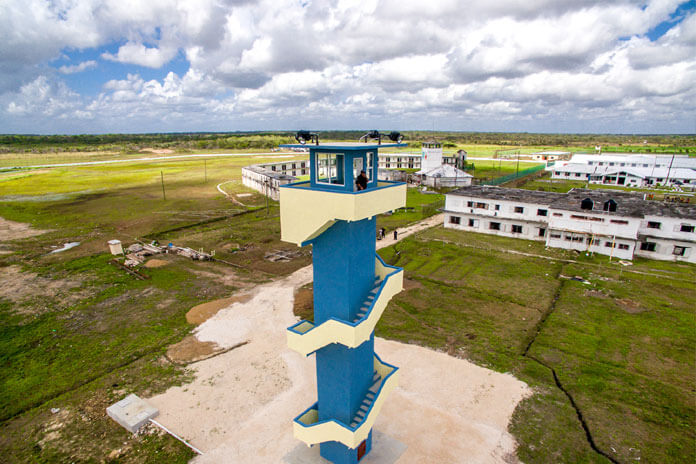BELIZE CITY, Thurs. Feb. 11, 2021– On October 12, 2020, at the height of the COVID-19 pandemic in Belize, 28 inmates of the Belize Central Prison staged the largest jailbreak in the country’s history. The following day a riot inside the prison resulted in the death of one young inmate, Stephan Jenkins. As of January 31, 2021, all escapees — with the exception of Akeem Tillett, who was killed by police during their attempt to recapture him — have since been returned to the Belize Central Prison.
Earlier this week Amandala had a discussion with the CEO of the Kolbe Foundation (which manages the prison), Virgilio Murillo, and a Ph.D. holder in criminal justice, Dr. Jarrod Sadulski, in an effort to take a deeper look into the historical jailbreak and the measures implemented since then.
CEO Murillo gave a broad outline of the measures that have been put in place since the prison break, although he did not give a detailed description of any particular system that is now being used. He said that the foundation took a three-pronged approach in addressing the jailbreak.
“We have certainly improved our security, without going into the details of what systems we’ve put in place. What I can assure the country and the public at large is that we’ve put a lot of systems in place, we’ve improved certain areas. What I did when this thing happened, I went and I analyzed the entire situation and I broke it down into literally three things. What happened. What caused it. And correctional or remedial actions,” CEO Murillo explained.
After the situation was assessed from those three angles, enhanced security systems were put in place inside the prison. All this was done while the prison continued its COVID-19 response. CEO Murillo shared that while the facility continues to operate on a shoestring budget, the implementation of the new measures is being shouldered by the current staff, who have all taken on additional roles.
“It boils down to being dynamic, in the sense that you have to try to find the cheapest way of doing business. Like I said, the COVID brought on its own set of woes for the prison, because with our shoestring budget that we are operating on prior to COVID, [COVID] ended up sort of stretching that, I guess, to the breaking limit. But thank God we managed to pull through, we managed to implement some things that did not really come at a cost. It just required that our people are capable or able to multitask. In essence, we continue to get a two for the price of one type thing,” CEO Murillo said.
He shared that the prison’s management is concerned that the staff may suffer burnout as a result of the additional tasks. In January 2020, Dr. Jarrod Sadulski visited the Belize Central Prison and conducted a one-week training in the areas of hostage-taking, escapes, and riots with staff members. He observed that the professionalism and drive of the employees were unmatched when compared to other prisons he has studied across the Americas. Because of this, Dr. Sadukski expressed his belief that the Belize Central Prison should serve as a model for all similar facilities across this region.
”I actually provided the training to the 250 staff members at the prison, and what I found was a significant level of professionalism and dedication to their work. These members at the Belize Central Prison believe in the mission of Kolbe, they believe in what they do every day, they believe in proper prison care. I’ve studied prisons throughout the Americas, North, Central, South America, and Europe. I believe the Belize Central Prison should be the role model in terms of the operating model for prisons because of the strength in their rehabilitation programs as well as the treatment of the inmates by the staff,” Dr. Sadulski said.
We asked CEO Murillo to describe the atmosphere at the facility and any possible tensions in the interaction between staff and inmates prior to the prison break and the riot which occurred the following day. Some captured escapees have said that their fear of being infected with COVID-19 inside the prison triggered their decision. CEO Murillo has gone on the record to disagree with this and said that the inability of prisoners to access drugs, particularly marijuana, as a result of the movement restrictions inside the prison, could have been the catalyst for the prison break.
“I will insist that as much as the inmates that escaped and rioted the following morning would want the public to believe that they did it because of the COVID-19 pandemic, I will not say that is the situation.” CEO Murillo said.
He added, “I will tell you that when COVID came knocking at our doors in September, that literally meant that I would have shut down the prison, and it means that things would have gotten tighter in terms of visits, and this is how prisoners get their drugs into the prison — through visits. They get to come to the prison and then throw it in the yard, and then the guys that come out to work pick it up and they do what you call ‘relay’ the drugs until they get it to the rightful owner.”
“I am sure that it was the lack of that drugs that could have been… it’s like a famine then. We run it so tight that it’s hard to get drugs in right now as it is. Imagine when there is a complete lockdown; it makes it even worse for them,” CEO Murillo said.
We will continue this article in the next issue…

